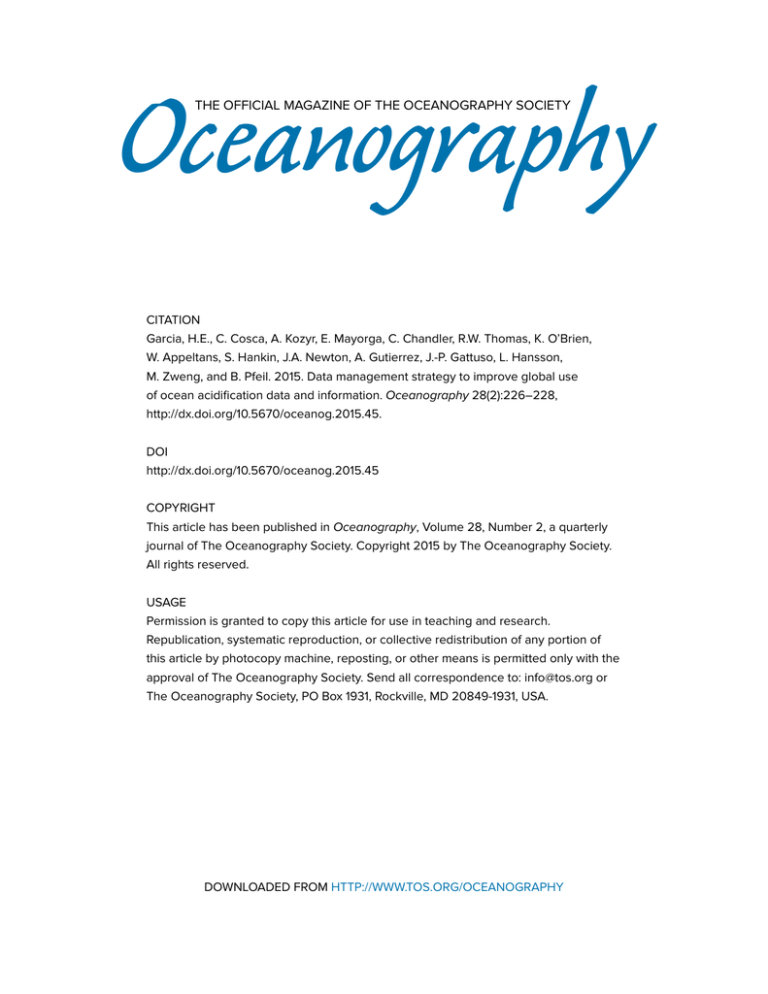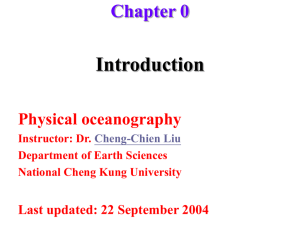
Oceanography
THE OFFICIAL MAGAZINE OF THE OCEANOGRAPHY SOCIETY
CITATION
Garcia, H.E., C. Cosca, A. Kozyr, E. Mayorga, C. Chandler, R.W. Thomas, K. O’Brien,
W. Appeltans, S. Hankin, J.A. Newton, A. Gutierrez, J.-P. Gattuso, L. Hansson,
M. Zweng, and B. Pfeil. 2015. Data management strategy to improve global use
of ocean acidification data and information. Oceanography 28(2):226–228,
http://dx.doi.org/10.5670/oceanog.2015.45.
DOI
http://dx.doi.org/10.5670/oceanog.2015.45
COPYRIGHT
This article has been published in Oceanography, Volume 28, Number 2, a quarterly
journal of The Oceanography Society. Copyright 2015 by The Oceanography Society.
All rights reserved.
USAGE
Permission is granted to copy this article for use in teaching and research.
Republication, systematic reproduction, or collective redistribution of any portion of
this article by photocopy machine, reposting, or other means is permitted only with the
approval of The Oceanography Society. Send all correspondence to: info@tos.org or
The Oceanography Society, PO Box 1931, Rockville, MD 20849-1931, USA.
DOWNLOADED FROM HTTP://WWW.TOS.ORG/OCEANOGRAPHY
EMERGING THEMES IN OCEAN ACIDIFICATION SCIENCE
Data Management
Strategy to Improve Global Use of Ocean Acidification
Data and Information
By Hernan E. Garcia, Cathy Cosca,
Alex Kozyr, Emilio Mayorga,
Cynthia Chandler,
Robert W. Thomas, Kevin O’Brien,
Ward Appeltans, Steve Hankin,
Jan A. Newton, Angelica Gutierrez,
Jean-Pierre Gattuso,
Lina Hansson, Melissa Zweng,
and Benjamin Pfeil
226
Oceanography
| Vol.28, No.2
Ocean acidification (OA) refers to the general decrease in pH of the global ocean as a
result of absorbing anthropogenic CO2 emitted in the atmosphere since preindustrial
times (Sabine et al., 2004). There is, however, considerable variability in ocean acidification, and many careful measurements need to be made and compared in order to obtain
scientifically valid information for the assessment of patterns, trends, and impacts over
a range of spatial and temporal scales, and to understand the processes involved. A single country or institution cannot undertake measurements of worldwide coastal and
open ocean OA changes; therefore, international cooperation is needed to achieve that
goal. The OA data that have been, and are being, collected represent a significant public investment. To this end, it is critically important that researchers (and others) around
the world are easily able to find and use reliable OA information that range from observing data (from time-series moorings, process studies, and research cruises), to biological
response experiments (e.g., mesocosm), data products, and model output.
Two major factors currently limit
access to OA data. First, the data reside
in many geographic locations in varying
formats, are subject to different data quality procedures, and are described using
different vocabularies and metadata
(descriptions of information relevant
to the data; e.g., methods and chemical
standards used). Second, the data are not
made available using interoperable online
services that would allow data queries
across different networks, making it difficult to discover and access data from a
single, “one-stop” location. In addition,
researchers may need to request permission to use the data from a particular data
source, and then convert the data into a
common digital format such as Network
Common Data Form (NetCDF) in order
to make comparisons and syntheses.
Data managers from a wide range of
institutions are developing ideas for a
much more coordinated global OA data
management system to improve public access to observations, experiments,
and data synthesis products and to enable
human-to-machine and machine-tomachine data transactions across different networks. The proposed system will
enable different data network services to
communicate and exchange OA data in
a consistent manner. It will also facilitate
data integration, for example, combining
multidisciplinary observational in situ
and remotely sensed data into a single
data stream. The goal is to meet the current information needs of both researchers and policymakers with minimal cost
while maximizing the long-term benefits
to scientific research.
This data management strategy is
closely aligned to the Global Ocean
Acidification
Observing
Network
(GOA-ON), based on already existing OA data-gathering activities (repeat
hydrographic surveys, time-series stations, moorings, float and glider observations, and volunteer observing ships),
with additional observations to cover
biological impacts. GOA-ON was initiated in 2012 by scientists from 28 countries, recognizing that its success depends
on an ambitious vision to improve the
international coordination of OA data
management (Newton et al., 2014).
A common OA data access Web data
portal (a “one-stop shop”) will benefit from adoption of uniform best practices for scientific management of the
data. The Web portal needs to accept
and deliver data (and associated documentation) from data centers, data publishing locations, academic institutions,
and other data partners. Figure 1 illustrates the scientific stewardship data life
cycle for making globally distributed
data of known quality available through a
user-friendly search and access data portal. This portal should enable easy discovery, access, long-term archiving, and
visualization of the wide range of observations and their associated data products. The data system architecture needs
Data Source:
Research
Scientists
to build on existing data management
practices employed at national and international levels, emphasizing measurement collection, end-to-end data management (data life cycle from collection
of data up to information, data products,
and long-term archiving), and research
aligned with the goals of the ocean acidification community. However, the proposed system is not intended to solve all
of the problems and challenges associated
with managing OA data, and much work
(and goodwill) is needed to fully implement such a system.
Serving these diverse globally distributed data will require a cooperative
approach between scientists and data
managers. Open and full sharing of scientific observational data and associated
metadata will be needed in order to study
the ocean as a system, to provide timely
OA Scientific Stewardship
data life-cycle
Data Source:
Data
Managers
Best practices
metadata content
and formats
Data
provenance
and
attribution
Data quality
control metrics
Global user
search and
access data
portal
Easy data
discovery,
access, and
archival
Interoperable
Data Services
Data Integration
Data Access
Policy
Data source:
Data Synthesis
groups
Data Source:
National and
World Data
Centers
FIGURE 1. Conceptual representation of scientific stewardship for ocean acidification data, showing
how globally distributed data of known quality can be made discoverable and accessible through a
data portal via interoperable data services.
Oceanography
| June 2015
227
and reliable forecasts and warnings, to
conserve and manage marine resources,
and to support informed economic and
regulatory decisions.
Detailed metadata are necessary for
valid and consistent use of OA data by
the scientific community now and into
the future (Dickson et al., 2007; Riebesell
et al., 2010). For instance, information
is needed on measurement protocols,
whether Certified Reference Materials
were used, pH scales (National Bureau
of Standards, free, total, or seawater),
reporting units and nomenclature of
measured and calculated variables, data
reproducibility, and other relevant data
such as temperature and salinity.
Clear policies will be needed that
address timely availability and sharing of
data, including the use of unique and citable digital identifiers to ensure appropriate attribution, provenance-tracking, and
recognition of the scientists and project
programs responsible for collecting and
analyzing the data. While scientific journals increasingly require archiving of data
that support scientific results, the data
are not always easily found nor are they
made to conform to common digital formats that would allow their wider re-use.
Quality control of the data is the responsibility of the scientists collecting the data
and research groups assembling data synthesis products. The main purpose here is
to design a system that serves the critical
needs for data and information discovery
and access in a coordinated manner.
When creating an appropriate
data-sharing framework for OA data,
it is critical to learn from, and build
on, the data stewardship experiences
of other international efforts. Examples
of such efforts include WOCE (World
Ocean
Circulation
Experiment),
EPOCA (European Project on OCean
Acidification), CLIVAR (Climate and
Variability), GLODAP (GLobal Ocean
Data Analysis Project), and SOCAT
(Surface Ocean CO2 Atlas). These are
examples of high-quality data compilation products that generally address specific ocean observational and scientific
228
Oceanography
| Vol.28, No.2
communities. To help ensure wide dissemination of the data and information,
it will be important to coordinate closely
with international programs and initiatives
such as OA-ICC (Ocean Acidification
International Coordination Centre),
IODE (International Oceanographic
Data and Information Exchange of
the Intergovernmental Oceanographic
Commission of UNESCO), International
Ocean Carbon Coordination Project
(IOCCP), GEO (Group of Earth
Observations), and others.
The OA data management actions outlined here provide an adaptable coordination strategy based on collaboration between scientists, data centers, and
data publishers, and promote the adoption of common data retrieval protocols and best practices for OA metadata
production and long-term preservation across political boundaries. Given
the importance of assessing OA variability and ecosystem responses at
local, regional, and global levels, and at
daily to interannual time scales, a wellcoordinated and internationally agreed
upon OA data management and access
strategy can be considered an essential
component of environmental security
and global resilience management.
REFERENCES
Dickson, A.G., C.L. Sabine, and J.R. Christian. 2007.
Guide to best practices for ocean CO2 measurements. PICES Special Publication 3:1–191,
http://cdiac.ornl.gov/ftp/oceans/Handbook_2007/
Guide_all_in_one.pdf.
Newton, J.A., R.A. Feely, E.B. Jewett, P. Williamson,
and J. Mathis. 2014. Global Ocean Acidification
Observing Network: Requirements and
Governance Plan. First Edition, 60 pp.
http://goa-on.org/docs/GOA-ON_plan_print.pdf
Riebesell, U., V.J. Fabry, L. Hansson, and J.-P. Gattuso,
eds. 2010. Guide to Best Practices for Ocean
Acidification Research and Data Reporting.
Luxembourg: Publications Office of the European
Union, 260 pp., http://www.epoca-project.eu/index.
php/guide-to-best-practices-for-ocean-acidification-
research-and-data-reporting.html.
Sabine, C.L., R.A. Feely, N. Gruber, R.M. Key,
K. Lee, J.L. Bullister, R. Wanninkhof, C.S. Wong,
D.W.R. Wallace, B. Tilbrook, and others. 2004.
The oceanic sink for anthropogenic CO2.
Science 305:367–371, http://dx.doi.org/10.1126/
science.1097403.
AUTHORS. Hernan E. Garcia (hernan.garcia@
noaa.gov) is Oceanographer, National Oceanic and
Atmospheric Administration (NOAA), National Centers
for Environmental Information (National Oceanographic
Data Center), Silver Spring, MD, USA. Cathy Cosca is
Physical Scientist, NOAA Pacific Marine Environmental
Laboratory, Seattle, WA, USA. Alex Kozyr is Scientist,
Carbon Dioxide Information Analysis Center, Oak
Ridge National Laboratory, Oak Ridge, TN, USA.
Emilio Mayorga is Senior Oceanographer, University
of Washington Applied Physics Laboratory, Seattle,
WA, USA. Cynthia Chandler is Information Systems
Associate, Biological & Chemical Oceanography Data
Management Office, Woods Hole Oceanographic
Institution, Woods Hole, MA, USA. Robert W. Thomas
is Data Scientist, British Oceanographic Data Centre,
Liverpool, UK. Kevin O’Brien is a software engineer
for the University of Washington/Joint Institute for
the Study of the Atmosphere and Ocean (JSIAO),
Seattle, WA, USA. Ward Appeltans is Program
Specialist, International Oceanographic Data and
Information Exchange (IODE) of the Intergovernmental
Oceanographic Commission of UNESCO, Oostende,
Belgium. Steve Hankin is Computer Scientist, NOAA
Pacific Marine Environmental Laboratory, Seattle, WA,
USA. Jan A. Newton is Senior Principal Oceanographer,
University of Washington Applied Physics Laboratory,
Seattle, WA, USA. Angelica Gutierrez is Hydrologist,
NOAA, National Weather Service, Silver Spring, MD,
USA. Jean-Pierre Gattuso is Research Professor,
Centre National de la Recherche Scientifique/
Université Pierre et Marie Curie - Paris 6, Villefranchesur-Mer, France. Lina Hansson is Project Officer,
Ocean Acidification International Coordination
Centre, International Atomic Energy Agency
Environment Laboratories, Monaco. Melissa Zweng
is Oceanographer, NOAA, National Centers for
Environmental Information (National Oceanographic
Data Center), Silver Spring, MD, USA. Benjamin Pfeil Is
Senior Engineer, University of Bergen, Bergen, Norway.
ARTICLE CITATION
Garcia, H.E., C. Cosca, A. Kozyr, E. Mayorga, C. Chandler,
R.W. Thomas, K. O’Brien, W. Appeltans, S. Hankin,
J.A. Newton, A. Gutierrez, J.-P. Gattuso, L. Hansson,
M. Zweng, and B. Pfeil. 2015. Data management strategy to improve global use of ocean acidification data
and information. Oceanography 28(2):226–228,
http://dx.doi.org/10.5670/oceanog.2015.45.





